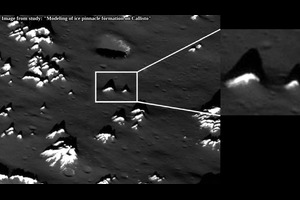 |
| Region of Milky Way galaxy where Sun was formed |
 |
| Size of Sun’s solar flair compared to Earth |
Because of how far the Sun is from us, it seems much smaller than it really is, The Sun is more than 100 times the width of the Earth, the Sun is so large that if it were a hollow ball more than million Earths could fit inside the Sun. The Sun is the largest object in the solar system, in fact if we collect everything in the solar system including the Sun, planets and dwarf planets, comets, asteroids and moons the Sun would account for more than 99% of it with everything else adding up to less than 1% of the solar system. As far as stars go however, the Sun is average or even small in size, the Sun is called a yellow dwarf and there are billions of yellow dwarfs in our Milky Way galaxy alone.
The Sun can be divided into six layers or regions namely Corona, Chromosphere, Photosphere, Covective zone, Radiative zone and the core. In terms of atom count the Sun is about 91% hydrogen which is the Sun’s fuel, 8.9% helium and 0.1% heavier elements such as carbon and nitrogen, due to the Sun’s extreme temperatures these elements stay in a gas like phase called Plasma. Like all other stars the Sun is made of gases, mostly hydrogen, helium and traces of some other elements, these gases are held together by Sun’s gravity which creates such intense heat and pressure that it causes nuclear fusion which is a process where hydrogen atoms fuse to create helium at it’s core.
The temperatures of Sun’s core are about 27 million degree fahrenheit or 15 million degree celsius, by the time the heat from the Sun’s core reaches it’s surface temperatures drop considerably and because of that the surface of the Sun is at much lower temperatures which is about 10,000 degree fahrenheit or 5500 degree celsius compared to core. Unlike the Earth or any other rocky planet the Sun does not have a solid surface, you may be surprised to learn that the Sun’s gassy surface is not calm and quite, instead the Sun is constantly moving and changing with sunspots or dark patches at cooler temperatures and solar flairs or eruptions of high energy radiation frequently marking it’s surface.
All of the planets in the solar system including Earth orbit around the Sun, in turn the solar system orbit around the center of the galaxy where we live which is Milky Way. It takes only 1 year for the Earth to orbit around the Sun but scientists estimate that it would take the Sun about 230 million Earth years to complete orbit around the Milky Way galaxy. Since ancient times humans have understood how important the Sun is for life on Earth, without the energy provided by the Sun’s radiation the Earth would be dark, cold and uninhabitable, although the Sun has been studied for hundreds of years there is still much to learn about the Sun.



